Sometime in 1908, near as I can tell, old Josiah Hoosier was sitting under a shagbark hickory in his favorite southern Indiana squirrel woods. Comprised of a nice mix of hardwoods, the forest’s mast crop was bound to attract a hungry bushy-tail soon enough. Not long after sunrise, he heard a critter coming his way. The manner in which it disturbed the leaf litter indicated it was – big, four-footed, and coming at a trot. Likely someone’s black and tan, loose and out for a morning run Josiah imagined. He sat statue-still under his tree as the approaching animal neared the crest of a hill not twenty yards in front of him. Much to his surprise, the creature that topped the rise wasn’t a coon hound at all. Still unaware of Josiah, and still at a trot, there appeared a gray wolf. It had been a mighty long spell since he’d seen a wolf. But he still held the belief that the only good wolf was a dead one and he didn’t hesitate. Josiah greeted the ill-fated animal with both barrels of number five buckshot. In so doing, Josiah deprived me of any chance of ever seeing a wild gray wolf in Indiana; he had killed the very last one. 
Of course, I can’t verify the historicity of this particular sequence of events. I am however confident in the depiction of the animosity toward wolves harbored in the breast of a good many folks. The hatred of wolves seems to have come to North America with the original European colonists. Native Americans, living here for thousands of years before the arrival of these colonists, seemingly had no such loathing toward wolves. Their conceptions of wolves varied. In some cultures wolves were seen as fierce fighters, in others larcenous apparitions; still others admired them for their cunning and hunting skills. There seems to have been no innate detestation of them. For early colonists however, there was no ambiguity. Wolves were an enemy to be eradicated.
Our country’s battle with wolves started immediately. In 1630, a couple of years after its establishment, the Massachusetts Bay Colony offered a bounty on wolves. This was the first of many bounties to follow as our nation expanded westward. One may wonder why this antipathy for wolves existed but it is, I believe, fairly simple to understand. The people who colonized our country were agriculturalists. Aside from the planting of crops their lifestyle, unlike that of Native Americans, was heavily dependent upon domestic animals. Colonists brought with them horses, cattle, pigs, chickens, and other assorted beasts. Their farms being carved from a wilderness, the boundaries of the homesteads lie right against these wilds. It wouldn’t take long for predators, such as wolves and cougars, to figure out it was a lot easier to kill a plodding cow than a fleet-footed white-tailed deer. Thus the wolf was viewed from a totally different perspective than that taken by North America’s aboriginal inhabitants. Perhaps another factor in the aversion to wolves is the genuine fear people seem to have in regards to encountering them. Although gray wolf attacks on humans are exceedingly rare, they have occurred. It wouldn’t take much stoking of the imagination, and collective gossiping, before a community perceived wolves as a real threat to human life. Given these factors, it is little wonder that the human-wolf conflict was quick to blossom.
In spite of feeling great sympathy for the plight of the gray wolf, I can empathize with these early colonists. In the oxymoronic tameness of what passes for wild, here in southwestern Indiana today, I’ve had my own battles. In our area, it is often the raccoon that tends to test the patience of one living in the country as we call it. Our house sits in a small patch of hardwood forest that provides good raccoon habitat. Believing that they were here first, my wife and I have always tried to cut them some slack. If they raid the bird feeders, I add more seed. If they dig up our newly planted spring flowers, we replant them. If they prowl the patio and stare in our bedroom window, we stare back. Only once in the nearly forty years we’ve lived here have they driven me to violence. One spring we were set upon by a big male who was seemingly possessed by an urge to set the record as the most destructive raccoon in Sullivan County. In the space of a few nights, his crimes were legion. First, he dug up over a hundred dollars worth of bedding plants my wife had put in. She patiently, albeit with some mumbling under her breath, replanted them. That night he dug them up again. She repeated the re-plantings. The raccoon moved on to other mischief. The third night he raided one of our bluebird boxes. The next morning I found the heads of the nestlings lying on the ground under the box. The raccoon followed this performance with a foray into our water garden where he proceeded to devour the resident koi. At this point, my displeasure was becoming palpable. His next target was a relatively expensive bird feeder. Carrying seed out to it the next morning, I found the feeder chewed and bent into a useless piece of junk. That was the last straw. I called upon my friend Mr. Remington and there were no more depredations.
And so, I can easily imagine the magnitude of losing a milk cow or a year’s supply of pork to a wolf. If one’s life literally depended upon the successful raising of livestock, raids by such predators simply couldn’t be tolerated. Nowadays, the threat posed by gray wolves is directed more toward the farmer or rancher’s bank account than his physical survival. Still, they could rightly argue that the continued existence of a business, as well as a way of life, was at stake. Thus, the conflict between man and wolf has been waged for generations and continues to create disputes even today.
Not surprisingly it is the wolves that have come out on the losing end in their confrontation with humans. State by state they have been extirpated. Even the federal government joined in the zealous drive to eliminate the gray wolf wherever it occurred. In 1914 the U.S. Biological Survey, originally formed to study certain non-game wildlife, was designated as the government’s main predator control agency. This agency then proceeded to enthusiastically wage a campaign of poisoning, trapping, and shooting against virtually every predator in the far west. Believing, erroneously, that elimination of predators was of long-term benefit to their prey species, anti-predator programs were even carried out within our parks. By 1926 the crown jewel of our national park system, Yellowstone, no longer had a viable population of gray wolves.
But there were people, even in those days, that came to realize extirpating wolves might not be such a good idea after all. In one of the classic conservation essays of all times, Aldo Leopold tells of his own role in the killing of a female wolf. This event occurred in 1909 in Arizona’s Apache National Forest where Leopold was working as a forester. Entitled Thinking Like a Mountain, Leopold’s essay appears in his posthumously published book, A Sand County Almanac. He wrote, “We reached the old wolf in time to watch a fierce green fire dying in her eyes.” Believing that fewer wolves meant more deer and a paradise for hunters, he had had no hesitation in shooting. However, upon looking into the eyes of the dying wolf, Leopold had a revelation. “. . . after seeing the green fire die, I sensed that neither the wolf nor the mountain shared such a view.” Henceforth, Leopold began to reassess the ecological role played by large predators. Now considered the father of wildlife management in the United States, he became convinced that predators exerted beneficial effects within their ecosystems. This is a finding borne out by subsequent years of research in wildlife biology.
Mountains do not think of course. So what was Leopold getting at when he suggested that “the mountain” didn’t share the notion that no wolves equaled hunter’s paradise? In his wonderful prose style, rich with metaphor, Leopold was elucidating an ecological concept that was both fundamental and farsighted. He was using the mountain as a symbol for what the nonspecialist might call “Mother Nature”. Others might see this interplay of predator and prey as a component of the complex inner-workings of the Gaia Hypothesis. My interpretation is that Leopold was thinking of what we more precisely refer to today as biodiversity. Even though the term hadn’t yet been coined, he intuitively understood that biodiversity should not be thought of as only the variety of organisms living with an ecosystem. Rather, we should think of biodiversity as also encompassing all of the ecological interactions among the members of a community. The gray wolf should not be thought of as simply one of the several species living in a particular area. Instead, when thinking about the wolf, we should consider what role it plays within the wilderness world it inhabits. Leopold himself originally saw wolves merely as destroyers of game animals. “But after seeing the green fire die . . .”, he came to realize that the wolf was actually an animal of critical importance to not only the health of deer herds but perhaps to the well-being of entire ecosystems. Leopold thus instinctively, and in prophetic manner, had arrived at the understanding of the gray wolf as what we today describe as a keystone species.
A keystone species is a member of an ecosystem whose presence and habits have important positive, wide-ranging, stabilizing impacts upon the system. Conversely, the removal of a keystone species can have broad, negative, destabilizing impacts upon an ecological community. The reintroduction of gray wolves into Yellowstone National Park serves as an excellent example of the former. As noted, viable wolf populations were absent from Yellowstone by 1930. In 1995 and 1996, after years of debate, petition signings, and lawsuits gray wolves were reintroduced into the park. These animals came from Canada and formed the basis of a population that now fluctuates around one hundred individuals in about ten or eleven packs. It was assumed that the wolves would impact the population of elk within the park. This the wolves certainly have done. It is estimated that as many as twenty-two elk are killed per wolf each year. Like other large predators, wolves tend to take a disproportionate number of elk which are aged or in poor health and thus cannot contribute to the overall vigor of the population. This is the primary reason wildlife biologists consider predation to be beneficial to the overall health of prey species herds.
The elk population of the Yellowstone National Park has been reduced by some fifty percent. 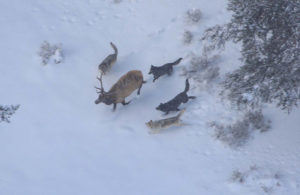 The reduction of elk numbers within the park has had some interesting ecological ripple effects. With the reintroduction of wolves, elk were no longer able to unconcernedly loaf about in the stream valleys of the park. Here they had browsed heavily upon riparian vegetation such as willow, cottonwood, and aspen trees. With the number of elk reduced, tree growth flourished. This in turn has led to an increase in the number of beavers within the park. These rodents eat the bark of trees such as willow; they also use the branches and logs cut from such trees to construct their dams and lodges. More beavers mean more beaver ponds. As a result there has been an increase in available habitat for waterfowl such as ducks, geese, and swans. Improved riparian habitat is also beneficial to songbirds (nesting habitat), trout (less siltation into streams), and moose (more browse and cover). Others animals which have benefited from the reintroduction of wolves in Yellowstone include scavengers such as ravens, eagles, and bears which may feed on the remains of wolf kills. The coyote population within Yellowstone NP was also cut by fifty percent. Wolves will kill coyotes and both species will prey upon the others’ pups given the chance. When wolves were removed from the park, the population of coyotes increased greatly. Coyotes are too small to prey upon elk but they were the primary predator upon pronghorn antelope calves. When coyote numbers were reduced by the presence of wolves once again, the population of antelopes in the park underwent an increase. Coyotes also compete with foxes and so populations of the latter have also gone up as a result of the presence of wolves. This so-called trophic cascade of impacts shows what a restored keystone species can accomplish given the opportunity and the time.
The reduction of elk numbers within the park has had some interesting ecological ripple effects. With the reintroduction of wolves, elk were no longer able to unconcernedly loaf about in the stream valleys of the park. Here they had browsed heavily upon riparian vegetation such as willow, cottonwood, and aspen trees. With the number of elk reduced, tree growth flourished. This in turn has led to an increase in the number of beavers within the park. These rodents eat the bark of trees such as willow; they also use the branches and logs cut from such trees to construct their dams and lodges. More beavers mean more beaver ponds. As a result there has been an increase in available habitat for waterfowl such as ducks, geese, and swans. Improved riparian habitat is also beneficial to songbirds (nesting habitat), trout (less siltation into streams), and moose (more browse and cover). Others animals which have benefited from the reintroduction of wolves in Yellowstone include scavengers such as ravens, eagles, and bears which may feed on the remains of wolf kills. The coyote population within Yellowstone NP was also cut by fifty percent. Wolves will kill coyotes and both species will prey upon the others’ pups given the chance. When wolves were removed from the park, the population of coyotes increased greatly. Coyotes are too small to prey upon elk but they were the primary predator upon pronghorn antelope calves. When coyote numbers were reduced by the presence of wolves once again, the population of antelopes in the park underwent an increase. Coyotes also compete with foxes and so populations of the latter have also gone up as a result of the presence of wolves. This so-called trophic cascade of impacts shows what a restored keystone species can accomplish given the opportunity and the time.
As one might imagine, the reintroduction of wolves into Yellowstone was not welcomed by all. Even today we continue to see the seemingly never ending argument over the place of wolves in our modern world. Should they continue to be protected under the 1973 Endangered Species Act? Should they be delisted? Should they be hunted? Should ranchers be compensated for livestock loss attributable to wolves?
Regardless of such questions, the overall ecological benefits of wolf reintroduction to the park ecosystem seem to me to be clear. Perhaps this demonstrates that wolves and men can have a truce in at least a few areas. Surely, for those of us who cherish wild places, this is not asking too much. To call for less than 1% of the lower forty-eight’s land area to be restored to a semblance of the primordial North America encountered by Lewis and Clark surely bespeaks a modest dream. We treasure the great works in our National Gallery of Art. We lovingly view the reminders of our cultural past in the National Museum of American History. Certainly the living museums of natural history represented by our monuments, refuges, and parks deserve our restorative nurturing as well.
And so, over the years, I had pretty much given up on ever seeing a wild gray wolf myself. I had always imagined seeing a wild wolf would be a fine experience. The gray wolf seemed to me the very emblem of places untamed and primeval, unsullied by the workings of man. But with the reintroduction of wolves to Yellowstone my expectations brightened. Finally, just a few short years ago, my hopefulness was rewarded. Anne and I had traveled out to Yellowstone in late September. It was a trip we had given ourselves in celebration of our retirement after a collective sixty-five years of public school teaching. It was our first trip to Yellowstone this late in the year. Gone were the huge crowds of summer that we had experienced on previous excursions there. There were still visitors aplenty but most were retirees like us.
Rising early in the morning to begin our game watching, we were reminded that we were at both a higher altitude and greater latitude than in Indiana. Back home, September is pretty balmy. The morning temperature in the park hovered in the high-teens and the windshield needed scraping. However, the brilliant clear air and bright sun made it seem much warmer. Stepping out of the cabin and inhaling the crisp, pine-scented morning air was wonderfully energizing. With great anticipation we motored off toward one of our favorite spots, Grizzly Overlook which lies just south of Canyon Village along the Yellowstone River. Along the way, even though their numbers may be fewer now, we saw many elk. At this time of year the bulls were in full rut. Here was another first for us, as we paused to watch a small herd of cows, the curious and unmistakable bugling of a bull echoed from the surrounding forest. Over the years, I have found that certain natural sounds have the ability to swiftly transport me back in time. The transition may be brief, but these sounds nevertheless give me the most satisfying illusion of being the only human present on the face of the earth. I stand alone in a primordial world unsullied by city or interstate highway, strip mall or strip mine, oil well or oil spill. The trumpeting of sandhill cranes cascading from unseen heights is one such sound. The eerie, falsetto bugling of a frantically amorous bull elk is another. I like best to hear this bugling when the enamored bull is actually out of my sight. Standing, patiently listening, I suddenly hear the distant herald descending down from a pine forested slope. Up there is wildness it tells me. Up there lay a world where mindfulness, fitness, and individuality are rewarded. Up there exists a world beyond the inanities of reality TV, political posturing, Facebook, and Twitter. Up there is the real world.
So it was, on this particular day, that we found ourselves standing on Grizzly Overlook. Other lovers of the wild were there too. Our spotting scopes were arranged in an orderly phalanx all looking northward up the valley of the Yellowstone. Wolves had been seen up that way the two previous mornings and so we waited. And then quite suddenly from an entirely different direction, off to the southwest, came a sound new to me but imminently recognizable. It was a sound which I can now file away, in my catalog of favorites, along with the wondrous music of cranes and elk. Rolling over the grass covered hills, borne on a westerly wind, came to us the mournful, drawn out howl of a wolf. Once, twice, three times the wail reached our collectively appreciative ears. And then the vocalization ceased and we were left with the sound of the wind playing over the grasses and through the riverside pines.  There were grins all around and glances were exchanged that asked, was that really a wolf? But yes, it was. There was no mistaking this deep, chesty, bawl for the high-pitched yapping of a coyote. We really had heard a wild gray wolf.
There were grins all around and glances were exchanged that asked, was that really a wolf? But yes, it was. There was no mistaking this deep, chesty, bawl for the high-pitched yapping of a coyote. We really had heard a wild gray wolf.
Gratifyingly satisfied, I returned to my spotting scope and scanned the sage flats north up the river valley. Minutes passed, then an hour. There was nothing. Patiently I waited and periodically I put my eye to the scope. There was nothing and then – wait – there was something. A black form moved through the sage and shimmering heat distortions of the air. The animal soon emerged into the open and I, at long last, was gifted with my first look at a wild gray wolf. What a wonderfully memorable experience this was. After so many years of hopeful dreaming, I had finally seen wilderness incarnate.
This wolf was soon followed by two other adults and two well-grown pups. With a determined bearing, they now continued on westward in that wonderful ground-eating trot that can carry a wolf uninterruptedly for miles. In fact, all too soon, their trot carried them out of sight behind a large hill to the northwest. Anne and I were ecstatic in regards to our good fortune in achieving our long-held goal of seeing a wild gray wolf. We decided to pack up and head back to Canyon Village for a reward of hot coffee. Leisurely driving north along the road from Lake Village to Canyon, we had just passed the Chittenden bridge junction when Anne shouted, “What’s that?” Following her gaze, I looked into a meadow on the west side of the road in time to see three adult gray wolves bounding through the grass. They were so close, mere yards away! After patiently waiting for just a distant scope view of a wolf, this was incredible luck. I even managed to quickly snap a few photos before the wolves disappeared into the surrounding lodgepole pine forest. As I reviewed the images something odd struck me. The wolves weren’t wet. Yet, here they were on the opposite side of the river from the group we had seen only minutes earlier. That pack was over on the east side of the Yellowstone River. For such territorial animals, it seemed odd to us that there would be another group so close to the Canyon Pack we had just seen.
When in doubt, ask a ranger. So, into the Canyon visitor center we went. No, that wasn’t another pack we were told. These were three of the adults we had seen on the other side of the river. Why weren’t they wet? Simple, said the ranger, they use the Chittenden Bridge to cross the Yellowstone. Of course, why hadn’t we thought of that? We immediately recalled a previous trip to Yellowstone during which we had shared the bridge with a passing herd of bison. They had looked quite impressive as they pressed against the side of our tiny car. We stared at each other literally eye to eye. Theirs’ was a mighty wild eye too I must add.
The park ranger explained that these wolves had more than likely left the pups with another adult while they were off to hunt for prey, a common gray wolf strategy. As Anne and I reflected on this information, there emerged an awareness of an especially impressive fact regarding these three wolves. It had taken us only a few minutes to hop in the car and drive the two miles to the spot where we encountered the wolves. In this same span of time they had left the valley of the Yellowstone, crossed the river itself, traversed an intervening stand of lodgepole pine, and darted across the main road. It gave us a graphic understanding of just how much ground a steadily moving wolf can cover.
I still couldn’t get over the thrill of being so close to wild gray wolves. The image of their proximity has stayed with me over the years. Two of them were a luxurious golden brown marked with white, while the third was the black I had first seen in the valley. Loping through the meadow, their mouths gaped as they gulped in the crisp morning air. I couldn’t help but anthropomorphize. To me, their expressions looked like nothing so much as the canine equivalent of broad, contented smiles. I tried to imagine the glorious wild freedom engendered in these three magnificent animals. Theirs’ was not a life of ease to be sure; there was hunger, intense cold, and violent death in their world. But this morning, all was well. The sky was clear and a lovely cerulean blue. The rising sun hinted at a pleasantly warm afternoon. A gentle breeze carried the scent of elk upon the air. These wolves inhabited a domain whittled to the bare bones of necessity: to hunt, to rear young, to stay alive individually and collectively. Not so different from our distant, and perhaps not so distant, ancestors as well. As I ruminated over these thoughts, their world seemed to me a realm distilled to its essence. I suppose I would have to admit to a fleeting emotion of envy for a life so devoid of the distractions, absurdities, and manufactured stresses of the world in which I live. Could this sentiment, I wondered, be what Thoreau was getting at when he said that “. . . in wildness is the preservation of the world”? Surely such a primal world could at least lead to the preservation of our sanity.
So you see, in accomplishing my dream of someday seeing a wolf in the wild, I achieved much. This was more than simply another species to add to my life list. The experience led me into my own cascade of more thoughtful considerations. I considered more deeply the relationships of predator and prey. My belief in the need for wild things and the wildernesses in which they can exist was verified. I now more fully recognize the impact of the presence, or the absence, of a keystone species. The sighting reinforced my conviction that Thoreau was more prescient than most people imagine. My encounter with gray wolves, and the subsequent understanding of how they have restored a semblance of the original Yellowstone ecosystem, opened another window as well. I now better grasp what Aldo Leopold meant when he spoke of thinking like a mountain.
In the end, stored in my memory bank like a precious Brasher doubloon, rests one last important observation of the wolves I saw hurrying through the Yellowstone meadow. As they neared the lodgepole pine stand on the far side of the clearing, an old she-wolf glanced back over her shoulder and, for the briefest of moments, our gazes met. Even now I recall that in her eyes there burned a fierce green fire.
Photo Credits:
howlingforjustice.wordpress.com
leesonphoto.photoseller.com
commons.wikimedia.org

 What beautiful birds they are. The female, like most members of the avian clan, shows her beauty in an understated perfection of camouflage. Just this morning, I watched her perched in the ash tree near the nest box. Shifting my gaze caused me to struggle a bit to relocate her feathered body of subtle browns and mottled breast. The male showed no need for such subtlety. The wild, orange-red eyes and beak were set upon a head of iridescent green marked with bold highlights of white. The chestnut breast and fawn flanks were overlain by a back that seemed black but suddenly morphed into lustrous emerald when he shifted position and the morning light struck from a different angle. One would be hard-pressed to find another North American bird which surpasses the beauty of a male wood duck.
What beautiful birds they are. The female, like most members of the avian clan, shows her beauty in an understated perfection of camouflage. Just this morning, I watched her perched in the ash tree near the nest box. Shifting my gaze caused me to struggle a bit to relocate her feathered body of subtle browns and mottled breast. The male showed no need for such subtlety. The wild, orange-red eyes and beak were set upon a head of iridescent green marked with bold highlights of white. The chestnut breast and fawn flanks were overlain by a back that seemed black but suddenly morphed into lustrous emerald when he shifted position and the morning light struck from a different angle. One would be hard-pressed to find another North American bird which surpasses the beauty of a male wood duck.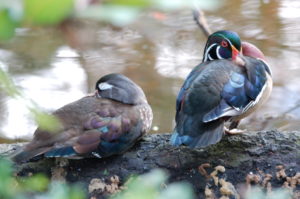 The duck escaped but barely. The male I saw this morning appeared again later in the day. This time with a red-shouldered hawk tailing him and showing what seemed a sinister interest. Yes, I think sneaking in and out of the nest box is a good idea.
The duck escaped but barely. The male I saw this morning appeared again later in the day. This time with a red-shouldered hawk tailing him and showing what seemed a sinister interest. Yes, I think sneaking in and out of the nest box is a good idea.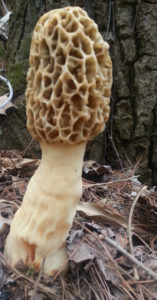 Successfully finding morels is something of a knack. Hunters who can spot a tiny morel at thirty paces and come home from a quest with bulging sacks of these delicacies are highly regarded in these parts. I dare say that I hold such a person in much higher esteem than a typical member of the Indiana legislature. I love to mushroom hunt but few would consider me an adept in this art. Nevertheless, along with my wife and daughter, we find our share. Weekends spent searching our woodlands for black, half-free, gray, and yellow morels have provided many an hour of pleasant companionship for us.
Successfully finding morels is something of a knack. Hunters who can spot a tiny morel at thirty paces and come home from a quest with bulging sacks of these delicacies are highly regarded in these parts. I dare say that I hold such a person in much higher esteem than a typical member of the Indiana legislature. I love to mushroom hunt but few would consider me an adept in this art. Nevertheless, along with my wife and daughter, we find our share. Weekends spent searching our woodlands for black, half-free, gray, and yellow morels have provided many an hour of pleasant companionship for us.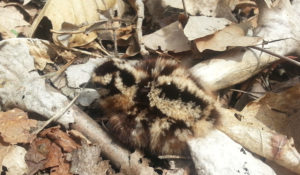 Tiny little balls of downy fluff they were. Their coloration was so cryptic and matched the dead leaves upon which they sat so well that I was somewhat astonished to have even spotted them. Not a millimeter did they move. Not an eye blinked. I carefully reached down and touched a down feather. Still as stone the crafty little mote remained. By such instinct do they remain invisible to fox and weasel. I slowly moved away secure in the knowledge that mom, listening intently just over the ridge, would soon return and lead the little brood away. Who could think of morels when bequeathed such a rare glimpse into the secret life of the woodcock?
Tiny little balls of downy fluff they were. Their coloration was so cryptic and matched the dead leaves upon which they sat so well that I was somewhat astonished to have even spotted them. Not a millimeter did they move. Not an eye blinked. I carefully reached down and touched a down feather. Still as stone the crafty little mote remained. By such instinct do they remain invisible to fox and weasel. I slowly moved away secure in the knowledge that mom, listening intently just over the ridge, would soon return and lead the little brood away. Who could think of morels when bequeathed such a rare glimpse into the secret life of the woodcock?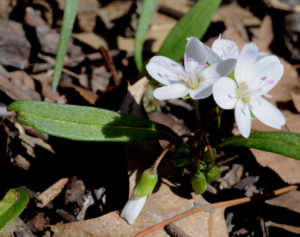 Digging into the soil I retrieve a filbert sized corm from one of the plants. Brushing away the soil, I pop the morsel into my mouth, crunch down, and am rewarded with an earthy, potato flavor. Nearby stands half a dozen specimens of toothwort. This small, white-flowered herbaceous plant is quite common in the woodlands of Indiana. I recall that the name refers to use of the plant’s segmented root as an herbal remedy for toothache. This in turn causes me to ponder upon the fact that
Digging into the soil I retrieve a filbert sized corm from one of the plants. Brushing away the soil, I pop the morsel into my mouth, crunch down, and am rewarded with an earthy, potato flavor. Nearby stands half a dozen specimens of toothwort. This small, white-flowered herbaceous plant is quite common in the woodlands of Indiana. I recall that the name refers to use of the plant’s segmented root as an herbal remedy for toothache. This in turn causes me to ponder upon the fact that 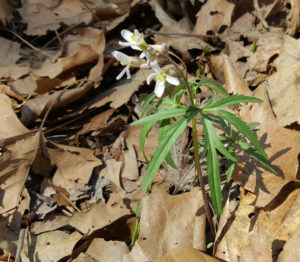 practically every plant I see around me was likely used in some way by Native Americans. Whether it be food, fiber, or building material that was needed, a plant that fit the bill could be found in their environment. The pioneers who displaced the native inhabitants were also aware, likely to a lesser degree, of the natural pharmacy and food larder that surrounded them. Sadly this is a knowledge and skill that is as nearly extinct among modern Hoosiers as the passenger pigeon. My guess is that the vast majority of modern humans are cerebrally disconnected from their continued reliance upon the plant kingdom for our survival. I dig up a small, two inch root of a toothwort and sample its texture and taste. Yes, very crispy as I had heard and it does indeed taste like horseradish.
practically every plant I see around me was likely used in some way by Native Americans. Whether it be food, fiber, or building material that was needed, a plant that fit the bill could be found in their environment. The pioneers who displaced the native inhabitants were also aware, likely to a lesser degree, of the natural pharmacy and food larder that surrounded them. Sadly this is a knowledge and skill that is as nearly extinct among modern Hoosiers as the passenger pigeon. My guess is that the vast majority of modern humans are cerebrally disconnected from their continued reliance upon the plant kingdom for our survival. I dig up a small, two inch root of a toothwort and sample its texture and taste. Yes, very crispy as I had heard and it does indeed taste like horseradish.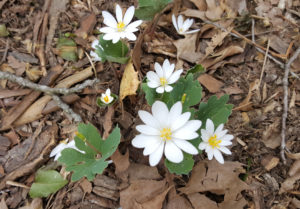 Of course I can’t neglect consideration of the woody plants. Redbud, my favorite, dogwood, and spicebush transform the nearly leafless forest into an impressionist opus. There is so much to see and muse upon here. How could anyone keep their mind on morels?
Of course I can’t neglect consideration of the woody plants. Redbud, my favorite, dogwood, and spicebush transform the nearly leafless forest into an impressionist opus. There is so much to see and muse upon here. How could anyone keep their mind on morels?